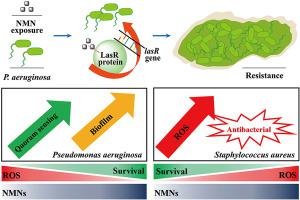Environmental Pollution ( IF 7.6 ) Pub Date : 2020-12-02 , DOI: 10.1016/j.envpol.2020.116138 Zhangqiang Li , Yunyun Zhang , Dan Huang , Le Huang , Haibo Zhang , Na Li , Meizhen Wang

|
Noble metal–based nanomaterials (NMNs), such as platinum nanoparticles (Pt@NPs) and palladium nanoparticles (Pd@NPs), are increasingly being used as antibacterial agents. However, little information is available on bacterial resistance to NMNs. In this study, owing to their oxidase-like and peroxidase-like properties, both Pt@NPs and Pd@NPs induce reactive oxygen species (ROS) and manifest antibacterial activities: 6.25 μg/mL of either Pt@NPs or Pd@NPs killed >50% of Staphylococcus aureus strain ATCC29213. However, Pseudomonas aeruginosa strain PAO1 completely resisted 12.5 μg/mL of Pt@NPs and 6.25 μg/mL of Pd@NPs. Compared to the non-NMN groups, these NMNs promoted 2–3-fold upregulation of the quorum sensing (QS) gene lasR in strain PAO1. In fact, the lasR gene upregulation induced a 1.5-fold reduction in ROS production and increased biofilm formation by 11% (Pt@NPs) and 27% (Pd@NPs) in strain PAO1. The ΔlasR mutants (lasR gene knock out in strain PAO1), became sensitive to NMNs. The survival rates of ΔlasR mutants at 12.5 μg/mL Pt@NPs and Pd@NPs treatments were only 77% and 58%, respectively. This is the first report indicating that bacteria can resist NMNs through QS. Based on these results, evaluation of the ecological risks of using NMNs as antibacterial agents is necessary.
中文翻译:

通过群体感应,铜绿假单胞菌可抵抗贵金属基纳米材料的毒性
铂纳米颗粒(Pt @ NPs)和钯纳米颗粒(Pd @ NPs)等贵金属基纳米材料(NMNs)越来越多地被用作抗菌剂。但是,关于细菌对NMN的抗药性的信息很少。在这项研究中,由于其类似氧化酶和过氧化物酶的特性,Pt @ NPs和Pd @ NPs均可诱导活性氧(ROS)并表现出抗菌活性:6.25μg/ mL的Pt @ NPs或Pd @ NPs被杀死> 50%的金黄色葡萄球菌菌株ATCC29213。然而,铜绿假单胞菌菌株PAO1完全抵抗12.5μg/ mL的Pt @ NP和6.25μg/ mL的Pd @ NP。与非NMN组相比,这些NMN促进了PAO1株中群体感应(QS)基因lasR的2-3倍上调。实际上,lasR基因上调导致PAO1菌株中ROS的产生减少1.5倍,并使生物膜形成增加11%(Pt @ NPs)和27%(Pd @ NPs)。所述ΔlasR突变体(LASR基因敲除菌株PAO1),成为到NMNS敏感。在12.5μg/ mL Pt @ NPs和Pd @ NPs处理下ΔlasR突变体的存活率分别仅为77%和58%。这是第一个报告表明细菌可以通过QS抵抗NMN。基于这些结果,有必要评估使用NMNs作为抗菌剂的生态风险。











































 京公网安备 11010802027423号
京公网安备 11010802027423号